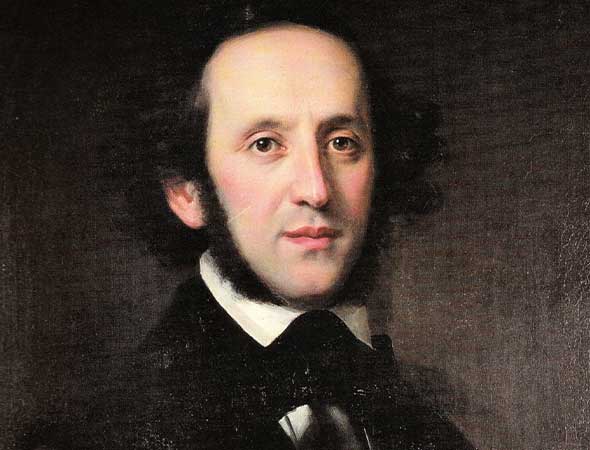MENDELSSOHN: Symphony No. 3 “Scottish”
Back in the 1970s, when your intrepid annotator took his first undergraduate music history course, the professor—a well-regarded musicologist and organist—got a bit melodramatic on the day of the Mendelssohn lecture. “Felix Mendelssohn’s parents saw a ghost,” he told the class gravely. Then he picked up a piece of chalk, held it on its side and wrote M-O-Z-A-R-T on the blackboard in huge, wavy letters, and followed this with tales of Mendelssohn’s Mozartean prowess as a musical prodigy. These days we’re rightly suspicious of such mythology, but for all its hyperbole, it is useful in reminding us of the basics.
Felix Mendelssohn was born in Hamburg in 1809, eighteen years after the death of Mozart. Like Mozart’s, Mendelssohn’s genius was evident from earliest childhood. Both had musically talented sisters and parents who were ambitious for their success. But as the scion of a wealthy Jewish family and the grandson of the philosopher Moses Mendelssohn, the young Felix was not viewed as someone whose talents were to be exploited for financial gain, as Leopold Mozart sought to do with Amadeus. Instead, Felix’s father Abraham moved his family to Berlin and made their residence there a salon that attracted the most prominent intellectuals of the day. Music and stimulating conversation were constants. Though Abraham and his wife Lea renounced Judaism and were themselves baptized along with their four children as Reformed Christians, the Mendelssohn name and heritage were well known in Europe, and the family never sought to conceal their ethnicity in cultivating their place in European cultural life.

Felix Mendelssohn
Young Felix did not begin piano studies with his mother until the relatively advanced age of six (far older than Mozart), but by then he had been demonstrating his musicality for years; according to another of those irresistible myths, the four-year-old Felix was already in bed for the evening when a visiting pianist pounded a C-major seventh chord and left it hanging, unresolved. Felix found the lack of finality unbearable. He ran downstairs to the piano, played the tonic chord with equal force, and scampered back to bed. The lesson here: Only a deeply musical soul could be so wounded by an unfinished cadence, and only someone with perfect pitch would know the right key without groping for it. By the time he was in his late teens, he had composed some of his best-known works, demonstrating both superb craftsmanship and a glorious gift for melodies that sing with emotion.
Upon close consideration, we find Mendelssohn to be one of those geniuses who proves that beauty and accessibility do not equate with shallowness. Behind the sunny disposition of his music lies the seriousness of one of the great musical intellects of his era. In his tragically short life (he died at age 38 in 1847), Mendelssohn achieved a statesmanlike position in European culture, directing one of the continent’s most important orchestras (the Leipzig Gewandhaus) and spurring revivals of interest in the music of Mozart and J.S. Bach. Most of all, Mendelssohn composed more than his share of indestructible all-time hits of the classical repertoire—including the violin concerto, the octet, the “Scottish” and “Italian” symphonies, and the incidental music to “A Midsummer Night’s Dream,” with its wedding recessional now a universal symbol for matrimony. (Ironically, it’s most often paired with the processional wedding march from Lohengrin by Wagner, who made Mendelssohn a target of his anti-Semitic rants.) Remarkably for such a popular composer, there is much more about Mendelssohn’s music, especially his majestic choral works, waiting to be discovered.
Some of Mendelssohn’s most brilliant musical inspirations came from his travels, as we can readily hear in the landscapes evoked in his compositions, and in their nicknames—the Italian Symphony, the Hebrides Overture and the Scottish Symphony, to name three. By his own account, Mendelssohn conceived the Scottish Symphony after his first visit to Great Britain in 1829. Following a successful series of performances in London, he embarked on a walking tour of Scotland with his friend Karl Klingemann and was particularly moved by the picturesque, evocative ruins of the chapel at Holyrood Palace in Edinburgh. In a letter describing this experience, he included a sketch of the symphony’s opening theme.
Despite the deep impression that this visit made and a quick start on the opening movement, Mendelssohn struggled with the symphony’s development. After a series of initial sketches, he laid the work aside in 1831. This interruption, apparently, was just what was needed; after resuming work in 1841, he was able to complete the symphony in the first weeks of the year 1841—the fifth and final symphony he composed, though the third to be published. The premiere was played in March, 1841 in the Leipzig Gewandhaus.
As we can readily hear in the Scottish Symphony, Mendelssohn’s “travel music” really does suggest the landscapes and cultures that inspired it. The symphony’s first movement is grand and joyful, with a briskness and energy that seem true to Scotland. This effect is even more marked in the lively second movement, which evokes the tunes and rhythms of Scottish folk music without directly quoting from Scottish sources. The contemplative third movement gives way to an energetic finale that draws from the rhythms of Scottish folk dances. In an elevated, German-style coda, Mendelssohn seems to conclude the symphony with a Scottish-German alliance of his own invention.











